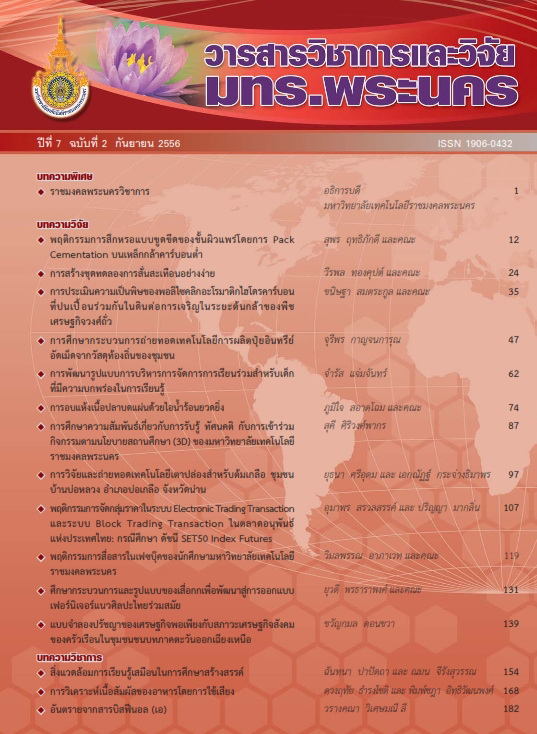พฤติกรรมการสึกหรอแบบขูดขีดของชั้นผิวแพร่โดยการ Pack Cementation บนเหล็กกล้าคาร์บอนต่ำ
Main Article Content
Abstract
บทคัดย่อ
งานวิจัยฉบับนี้ศึกษาพฤติกรรมการสึกหรอแบบขูดขีดของชั้นผิวแพร่โดยการ Pack Cementation บนเหล็กกล้าคาร์บอนต่ำ ส่วนผสมทางเคมีของการ Pack Cementation ประกอบด้วยเฟอร์โรซิลิคอน 42 เปอร์เซ็นต์, ทราย 17 เปอร์เช็นต์, แอมโมเนียคลอไรด์ 3 เปอร์เซ็นต์, ดินหนียว 12 เปอร์เซ็นต์, น้ำแก้ว 26 เปอร์เซ็นต์โดยน้ำหนัก โดยใช้อุณหภูมิการอบชุบ 950 และ 1050 องศาเซลเซียส เวลาอบชุบ 20 และ 30 ชั่วโมง โดยทำการวิเคราะห์โครงสร้างชั้นผิวแพร่ด้วยเครื่อง จุลทรรศน์อีเล็คตรอน และทำการทดสอบความแข็งผิวแพร่แบบวิเกอร์ ส่วนทดสอบการสึกหรออยู่ภายใต้มาตรฐาน ASTM G65 ด้วยเครื่องทดสอบแบบล้อยาง จากการทดลองพบว่าที่อุณหภูมิอบชุบ 1050 องศาเซสเซียส เวลาอบชุบ 20 ชั่งโมง มีค่าความแข็งชั้นผิวแพร่สูงสุดเฉลี่ย 394.26 HV0.02 อัตราการสึกหรอต่ำสุดเฉลี่ย 0.0751 กรัม ลักษณะการสึกหรอแบบร่องลึก และเวลาอบชุบ 30 ชั่วโมง ชั้นผิวแพร่สูงสุดเฉลี่ย 910 ไมครอน โครงสร้างที่เกิดในชั้นผิวแพร่ประกอบด้วย Fe5Si3, α1 และ aFe
Abstract
This research aims to study abrasive wear behavior of diffusion layer by pack cementation on low carbon steel. Chemical compositions of pack cementation include 42wt% Ferro-silicon, 17wt% sand, 3wt% NH4Cl, 12wt% clay, and 26wt% Liquid glass. The specimens were heated in the induction furnace at 950ºC and 1050ºC for 20 and 30 hrs. Microstructure of diffusion layer was analyzed with Optical and Scanning Electron Microscopy and hardness of diffusion layer was tested with a Vickers indenter. The abrasive wear tests were carried out in a Dry Sand Rubber Wheel abrasion machine according to ASTM G65 standard. Results showed that the heating temperature of 1050ºC for 20 hrs. yielded high hardness level of approximately 394.26HV0.02 and low average wear resistance of 0.0751g. The worn surface exhibited deep grooves. On the other hand, the heated treatment for 30 hrs. yielded the highest diffusion layer of approximately 910µm and the microstructure of Fe5Si3, α1 and aFe.


